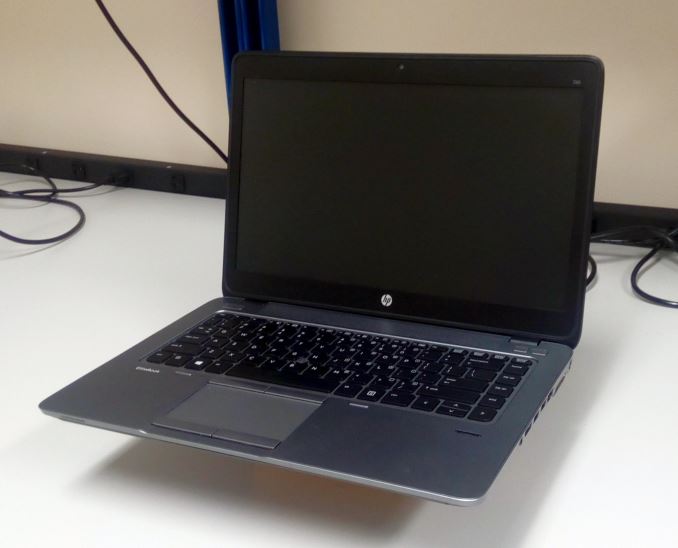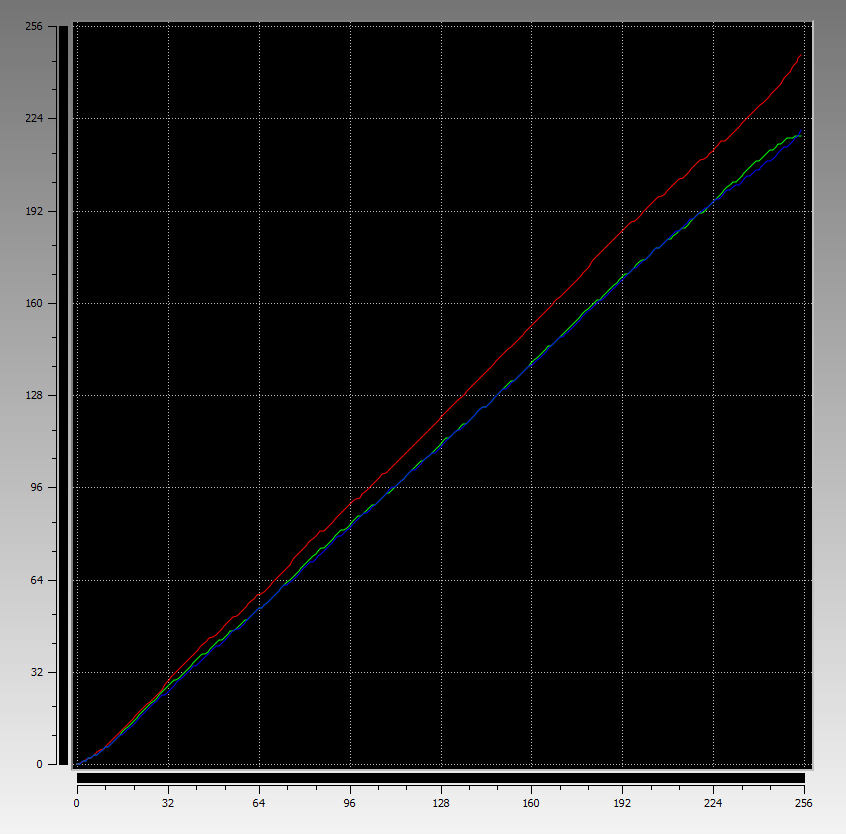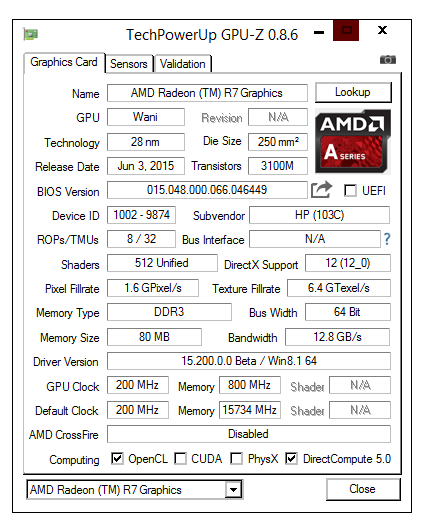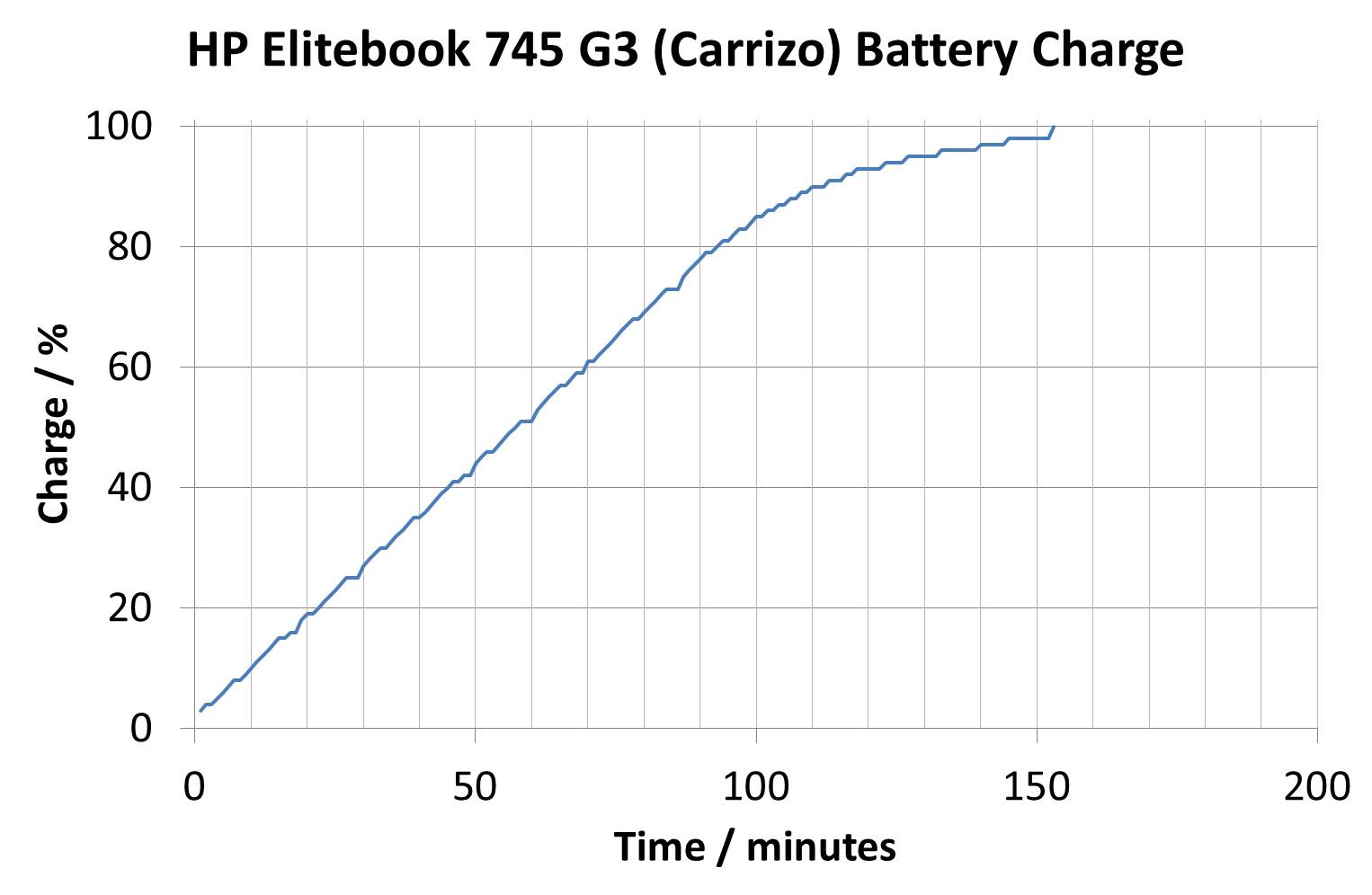Who Controls the User Experience? AMD’s Carrizo Thoroughly Tested
by Ian Cutress on February 4, 2016 8:00 AM EST#2 The HP Elitebook 745 G3 (Carrizo, PRO A12-8800B)
The Carrizo Elitebook 745 G3 looks practically identical to the Kaveri based 745 G2, so there’s no need to cover the visuals again, but the internals here cause a lot of talking points.
| HP Elitebook 745 G3 (Carrizo) Specifications | |
| Size and Resolution | 14-inch, 2560x1440 IPS |
| Processor | AMD PRO A12-8800B Dual module, 4 threads 2.1 GHz Base Frequency 3.4 GHz Turbo Frequency |
| Graphics | Integrated R7 512 Shader Cores 800 MHz maximum frequency GCN 1.2 |
| TDP | 15W |
| Memory | 4 GB in Single Channel Operation 1 x 4GB at DDR3L-1600 C11 2 SO-DIMM Slots |
| Storage | 128GB SSD |
| Battery Size | 45.76 Wh 3 cell Li-Po design, rated to 8.5 hours |
| WiFi | Broadcom Broadcom BCM943228Z 802.11ac 2x2 |
| Optical Drive | No |
| Dimensions | 13.3 x 9.3 x 0.74 in (non-touch) 13.3 x 9.3 x 0.80 in (touch) |
| Weight | 3.41 lb (non-touch) 3.76 lb (touch) |
| Webcam | 1280x720 |
| Other Features | Gigabit Ethernet 4 x USB 3.0 DisplayPort VGA Smart Card Reader |
| Operating System | Windows 8.1 |
| Website Link | link |
The G3 is almost the top premium model Carrizo you can buy, coming in at nearly $1100 if you put up the cash for the top model, which includes as much memory and storage you can fit in. For our unit, it came in at a more modest $700 ($700 for the base model, this was more $1100), which is more in-line with what price point AMD originally expected the Carrizo platform to hit. This is the first notebook with AMD’s new A12 line of processors, with this one being the PRO A12-8800B. This is a 15W part running at a base frequency of 2.1 GHz with a turbo mode up to 3.4 GHz. Any mobile APU in the A12 category has a full complement of 512 streaming processors similar to the FX mobile parts or A10 desktop parts, and the A12 runs these at 800 MHz. Unfortunately this is slightly crippled by only having the equivalent of one memory module in play, a single 4GB DDR3L-1600 module. It is dual channel capable if another is installed.
One of the big plus points with this model is the display, in comparison to the dire one on the G2, but this probably explains the majority of the cost in this 745 G3. With a 2560x1440 IPS display running a high contrast ratio (1422), it did have the best display out of what we tested for this piece. This is matched by the Wi-Fi solution, which had Broadcom’s BCM943228Z module which is an 802.11ac module in the M.2 form factor. One of the general feelings I had from the engineers here is that laptop Wi-Fi will all migrate to M.2 eventually on the understanding of better power control and form factor.
G3 Specific Testing
The 2560x1440 display varied from 0.21 nits all the way up to 297, nearly reaching the 300 mark but resulting in a 1422 contrast ratio. The white point was high, marking it up at 6657K.
While the color accuracy calibration graph looks as if the red line is the one going off on its own, it is actually the red line that is most accurate – we’re expecting a straight line through (0,0), (32,32), (64,64) and so on and while the red line is below most of these points, it isn’t as low as the green or blue.
The CPU-Z outlay shows the new FP4 socket with Carrizo over Kaveri, as well as having the full 12 compute units with those 512 SPs in tow.
On the integrated graphics side, despite the R7 graphics in there, the important element is that memory bandwidth running at 12.8 GB/s due to the single channel memory in use. We can also see the GPU clock running at 200 MHz idle, lower than the Kaveri implementation, which has power benefits.
With the 745 G3 we were able to do a run down on our light battery test, as well as run through some charge numbers.





















175 Comments
View All Comments
karakarga - Friday, February 5, 2016 - link
Including all, AMD and nVidia both at their funeral state! They can not possibly open 22, 14, 10 etc. micron fabric.Intel spended 5 billion dollars to open their new Arizona factory, they will pass lower processes there as well. AMD and nVidia can not get, even a billion dollar profit in these years. It is impossible for them to spend that much money to a new low process factory.
Those little tweaks can not help them to survive....
testbug00 - Friday, February 5, 2016 - link
They don't build factories. TSMC and Samsung (and GloFo to a lesser extent) build factories and do R&D for these processes. Nvidia, AMD. Samsung, Qualcomm, MediaTek and many other companies design chips to the standards of TSMC/Samsung/GloFo and pay money for wafers and running the wafers through the fab.The cost for this per wafer is meant to get all that money back in a few years. And than the process keeps on running for over 10 years sometimes.
It is getting more expensive to get to smaller nodes and the performance increase and power decrease is getting smaller. And costs more to design chips and run wafers. So it is getting harder to find the funds to shrink. Which is one of the reasons Intel has delayed their 10nm process.
yannigr2 - Friday, February 5, 2016 - link
Thanks for this review. Really needed for sometime. It was missing from the internet, not just Anandtech.As for the laptops, they say as much as there is to tell. Small Chinese makers, who no one knows they exist, would built better laptops than these. HP, Toshiba and Lenovo in this case, multibillion international giants that seems have all the technicians and the R&D funds necessary, end up producing Laptops with "strange" limitations, bad choices, low quality parts and in the end put prices that, even with all those bad choices and limitations, are NOT lower than those on Intel alternatives. It's almost as if Intel makes the choices for the parts in those laptops. Maybe their is a "trololol" sticker on them somewhere hidden addressed to AMD. I guess that way those big OEM don't make Intel too angry and at the same time, if there is another legal battle between AMD and Intel in the future, they will have enough excuses to show to the judge in their defense, if accused that they supported a monopoly.
ToTTenTranz - Friday, February 5, 2016 - link
This article is what makes Anandtech great. Just keep being like this guys, your work is awesome!I'm going to spend some time clicking your ads, you deserve it :)
As for the "poll" about who's to blame, IMHO it is:
1 - AMD for letting OEMs place Carrizo in designs with terrible panels and single-channel solutions. It's just not good for the brand. "You can't put a Carrizo with single-channel cheap RAM because that's not how it was designed. You want to build bottom-of-the-barrel laptop? We have Carrizo-L for you."
I'm pretty sure Intel has this conversation regarding Core M and Atom/Pentium/Celeron solutions. I know AMD is in a worse solution to negotiate, but downplaying Carrizo like this isn't good for anyone but Intel.
In the end, what AMD needs is a guy who can properly sell their product. Someone who convince the OEMs that good SoCs need to be paired with decent everything-else.
$500 is plenty for a 12/13" IPS/VA screen (even if it's 720/800p), 128GB SSD and 4+4GB DDR3L. Why not pull a Microsoft's Surface and build a decent SKU for that price range so that other OEMs can follow? Contract one OEM to make the device they envisioned, sell it and see all others following suit.
2 - OEMs for apparently not having this ONE guy who calls the shots and knows that selling a crappy system automatically means losing customers. And this ONE other guy (or the same) for not knowing that constantly favoring Intel with their solutions is bound to make the whole company's life miserable if Intel's only competitor kicks the bucket. The consumer isn't meant to know these things, but the OEMs certainly are.
It's 2016. We're way past the age of tricking the customer to buy a terrible user experience through big numbers (like "1TB drive woot"). He/She will feel like the money just wasn't and next time will buy a mac.
Want a $300-400 price point? Get a Carrizo-L with a 128GB SSD and a 720p IPS panel. Want $500-700 Price point? Get a Carrizo with dual-channel, 256GB SSD and 900p/1080p IPS screen.
joex4444 - Friday, February 5, 2016 - link
Anything under 1080p is simply not usable. All these 1366x768 panels are just awful. I have an old netbook with one (12.1") and I've put a small SSD in there and loaded it with Ubuntu. I cannot have a Google Hangouts window open and a web browser open wide enough to view most pages. Basic web browsing + IM - 1366x768 completely fails at the task.testbug00 - Friday, February 5, 2016 - link
768p panels are fine if they are good quality, in 11" laptops.900p good up to 13", and 1080p minimum for 14+.
Honestly I wish we stayed with 8:5 14x9, 16x10, 19x12z
jabber - Saturday, February 6, 2016 - link
Indeed, 768p is fine on my 11" Samsung Chromebook but I would not tolerate it on anything bigger. IMO 1600x900 should be the minimum screen res for budget machines. 1080p for midrange and whatever you like for higher end.jjpcat@hotmail.com - Monday, February 8, 2016 - link
Resolution is not as important as the quality of the panel. I used a Lenovo X1 Carbon. It has a 14" 1080p screen. But it's a TN panel and that just makes it a pain in the ass. I am amazed that Lenovo uses such a lousy panel in its $1k+ laptop while some 10" sub-$200 tablets use IPS.testbug00 - Friday, February 5, 2016 - link
Toshiba can make a $400 chromebook with a good 1080p display. Fully agreed.1080p panel, make it thicker so you can put a larger battery and so the laptop can handle up to 35W from the APU. Do dual channel.
When plugged change APU power mad to 35W, when in battery make it 15W. Probably can be done for $500 for a 15" laptop with an A8. $50/100 upgrade to 128/256GB SSD and $50/100 upgrade to A10/FX.
Dobson123 - Friday, February 5, 2016 - link
"The APU contains integrated ‘R6’ level graphics based on GCN 1.0, for 384 streaming processors at a frequency of 533 MHz."Isn't it GCN 1.1?